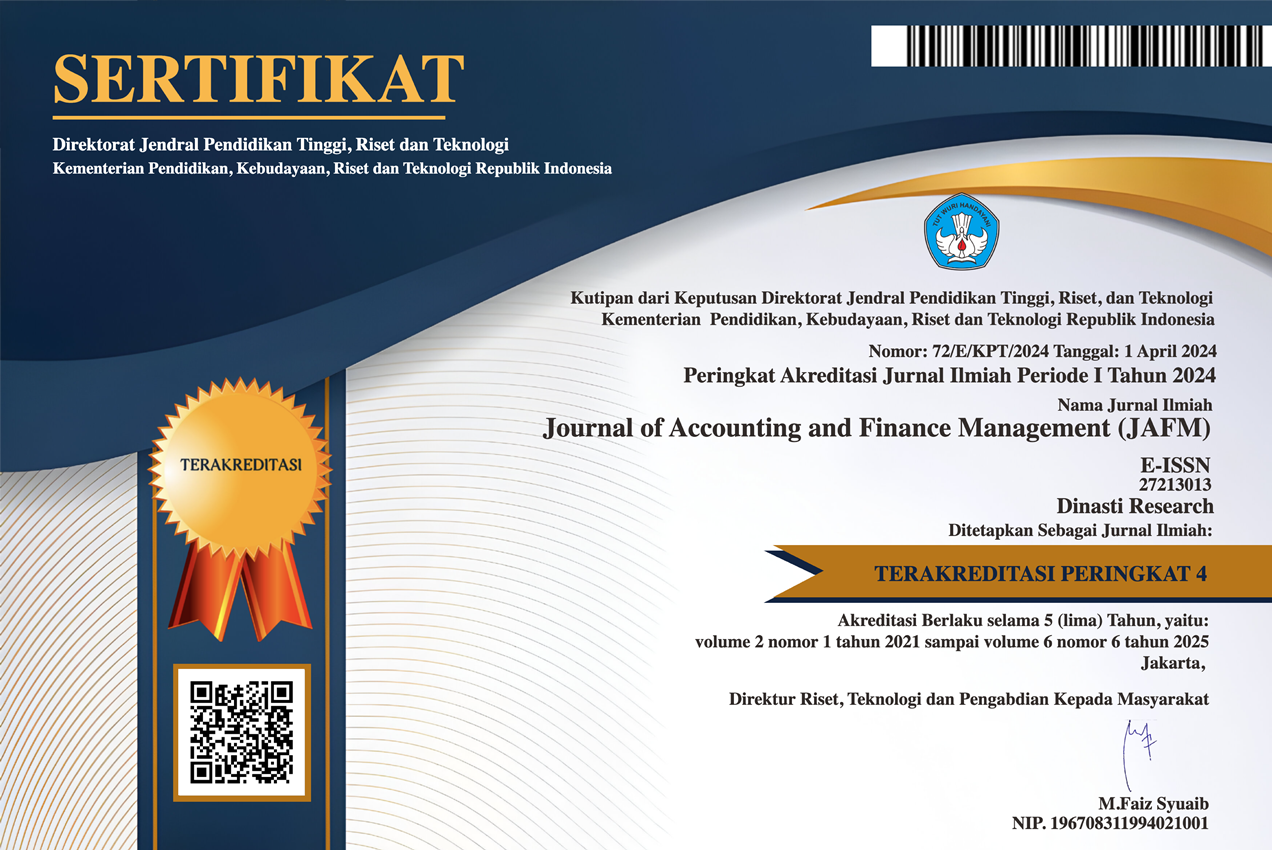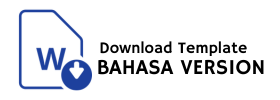Optimizing Accounting Information Systems: The Critical Roles of User Involvement and Cloud Computing Integration in Bandung, Indonesia
DOI:
https://doi.org/10.38035/jafm.v5i6.1375Keywords:
Accounting Information System, User Involvement, Cloud ComputingAbstract
Information technology within a company plays a crucial role in providing timely and accurate information that aligns with the needs of managers in decision-making. The quality of an Accounting Information System is reflected in a system that successfully integrates all necessary elements and sub-elements to produce high-quality information. This study aims to assess the influence of User Involvement and Cloud Computing on the Quality of Accounting Information Systems (QAIS) in private national banks located in Bandung, Indonesia. The method used in this study is SEM (Structural Equation Model) with the PLS (Partial Least Square) approach. The research sample consists of 81 respondents from 14 private banks. The results reveal that User Involvement has a notable and substantial impact on the Quality of Accounting Information Systems, contributing 49.7%. User engagement in the development and utilization of accounting information systems is vital for improving system quality. Meanwhile, Cloud Computing also significantly influences QAIS, though its contribution is smaller at 5.3%. Both factors contribute significantly, thus, these findings provide important insights for banking management, highlighting that improving the quality of Accounting Information Systems relies not only on the adoption of advanced technology but also on maximizing user engagement.
References
Abd El Rahman Rashwan, E. A. (2022). The Impact of The Adoption of Cloud Computing on Improving the Efficiency of Accounting Information Systems During The COVID-19 Pandemic. Journal of the Arab American University. Volume, 8(2). https://www.aaup.edu/sites/default/files/The%20Impact%20of%20The%20Adoption%20of%20Cloud%20Computing%20on%20Improving%20the%20Efficiency%20of%20Accounting%20Information%20Systems%20During%20The%20COVID19%20Pandemic.pdf
Abutaber, T. (2023). The moderating impact of cloud computing on the relationship between the reliability of accounting information systems and credit granting decisions in Jordanian banks. Uncertain Supply Chain Management, 11(4), 1811–1820.
Asosiasi Penyelenggara Jasa Internet Indonesia. (2022). Survei Profil Internet Indonesia 2022. https://survei.myapjii.id/download_survei
Ayu, A., & Syarifuddin, S. (2022). Keterlibatan Pengguna, Budaya Organisasi Dan Kompetensi Pengguna Terhadap Kualitas Sistem Informasi Akuntansi. AKUA: Jurnal Akuntansi Dan Keuangan, 1(3), Article 3. https://doi.org/10.54259/akua.v1i3.932
Bodnar, G. H., & Hopwood, W. S. (2013). Accounting information systems. Pearson. https://thuvienso.hoasen.edu.vn/handle/123456789/1572
Boroumandfar, G., Khajehzadeh, A., Eslami, M., & Syah, R. B. Y. (2023). Information gap decision theory with risk aversion strategy for robust planning of hybrid photovoltaic/wind/battery storage system in distribution networks considering uncertainty. Energy, 278, 127778. https://doi.org/10.1016/j.energy.2023.127778
Buana, I., & Wirawati, N. G. P. (2018). Pengaruh kualitas sistem informasi, kualitas informasi, dan perceived usefulness pada kepuasan pengguna sistem informasi akuntansi. E-Jurnal Akuntansi Universitas Udayana, 22(1), 683–713.
Chin, W. W. (2010). Bootstrap Cross-Validation Indices for PLS Path Model Assessment. In V. Esposito Vinzi, W. W. Chin, J. Henseler, & H. Wang (Eds.), Handbook of Partial Least Squares: Concepts, Methods and Applications (pp. 83–97). Springer. https://doi.org/10.1007/978-3-540-32827-8_4
Hair, J. F., Risher, J. J., Sarstedt, M., & Ringle, C. M. (2019). When to use and how to report the results of PLS-SEM. European Business Review, 31(1), 2–24. https://doi.org/10.1108/EBR-11-2018-0203
Hair Jr., J. F., Hult, G. T. M., Ringle, C. M., Sarstedt, M., Danks, N. P., & Ray, S. (2021). Partial Least Squares Structural Equation Modeling (PLS-SEM) Using R: A Workbook. Springer Nature. https://doi.org/10.1007/978-3-030-80519-7
Hassan, A., Bhatti, S. H., Shujaat, S., & Hwang, Y. (2022). To adopt or not to adopt? The determinants of cloud computing adoption in information technology sector. Decision Analytics Journal, 5, 100138. https://doi.org/10.1016/j.dajour.2022.100138
Ionescu, B., Ionescu, I., Tudoran, L., & Bendovschi, A. (2013). Traditional accounting vs. Cloud accounting. Proceedings of the 8th International Conference Accounting and Management Information Systems, AMIS, 106–125. https://www.researchgate.net/profile/LauraBrad/publication/260083245_QUANTIFYING_THE_ROMANIAN_BANKS'_PERFORMANCE_AND_THE_IMPACT_OF_AUDIT_INSPECTIONS_UPON_THEM_WHEN_IFRS_REPORTING_STANDARDS_IS_USED/links/0a85e534000ec1caed000000/QUANTIFYING-THE-ROMANIAN-BANKS-PERFORMANCE-AND-THE-IMPACT-OF-AUDIT-INSPECTIONS-UPON-THEM-WHEN-IFRS-REPORTING-STANDARDS-IS-USED.pdf#page=107
Kmaleh, A. I. M. (2023). The Impact of Using the Cloud Computing Upon the Quality of Accounting Information and it’s Reflection Upon the Development of the World Standards of Financial Reports in Jordanian Corporations. International Journal of Professional Business Review: Int. J. Prof.Bus. Rev., 8(9), 23.
Laudon, K. C., & Laudon, J. P. (2004). Management Information Systems: Managing the Digital Firm. Pearson Educación.
Maswadeh, S. (2024). The Effect of E-Commerce on Financial Performance Measured by Return on Asset and Tobin’s Q of Jordanian Service Companies. In B. Awwad (Ed.), The AI Revolution: Driving Business Innovation and Research: Volume 2 (pp. 1077–1088). Springer Nature Switzerland. https://doi.org/10.1007/978-3-031-54383-8_80
Nisa, A. S., Halimatusadiah, E., & Lestira, M. (2020). Pengaruh Keterlibatan Pengguna dan Dukungan Manajemen Puncak dalam Pengembangan Sistem terhadap Kualitas Sistem Informasi Akuntansi. Prosiding Akuntansi, 242–246.
Rapina, R., Carolina, Y., Joni, J., & Anggraeni, S. (2022). User Involvement In Information System Quality. International Journal of Innovative Technologies in Social Science, 4(36), Article 4(36). https://doi.org/10.31435/rsglobal_ijitss/30122022/7892
Sallehudin, H., Aman, A. H. M., Razak, R. C., Ismail, M., Bakar, N. A. A., Fadzil, A. F. M., & Baker, R. (2020). Performance and key factors of cloud computing implementation in the public sector. International Journal of Business and Society, 21(1), 134–152.
Samrotun, Y. C. (2014). Faktor – Faktor Yang Mempengaruhi Performance of Accounting Information Systems. Jurnal Paradigma Universitas Islam Batik Surakarta, 12(01), 116288.
Susanto, A. (2017). Sistem Informasi Akuntansi: Pemahaman Konsep Secara Terpadu. Lingga Jaya.//opaclib.inaba.ac.id%2Findex.php%3Fp%3Dshow_detail%26id%3D2733%26keywords%3D
van Velthoven, M. H., Wyatt, J. C., Meinert, E., Brindley, D., & Wells, G. (2018). How standards and user involvement can improve app quality: A lifecycle approach. International Journal of Medical Informatics, 118, 54–57. https://doi.org/10.1016/j.ijmedinf.2018.08.003
Wildana, F. (2017). Implementasi cloud computing di beberapa instansi pemerintahan. Puslitbang Aptika Dan IKP, Badan Litbang SDM, Kemenkominfo. Jurnal Masyarakat Telematika Dan Informasi, 8(2). https://www.academia.edu/download/85713303/99.pdf
Downloads
Published
How to Cite
Issue
Section
License
Copyright (c) 2025 Vicky Dzaky Cahaya Putra, Ghea Revina Wigantini

This work is licensed under a Creative Commons Attribution 4.0 International License.
Authors who publish their manuscripts in this journal agree to the following conditions:
- The copyright on each article belongs to the author(s).
- The author acknowledges that the Journal of Accounting and Finance Management (JAFM) has the right to be the first to publish with a Creative Commons Attribution 4.0 International license (Attribution 4.0 International (CC BY 4.0).
- Authors can submit articles separately, arrange for the non-exclusive distribution of manuscripts that have been published in this journal into other versions (e.g., sent to the author's institutional repository, publication into books, etc.), by acknowledging that the manuscript has been published for the first time in the Journal of Accounting and Finance Management (JAFM).



























